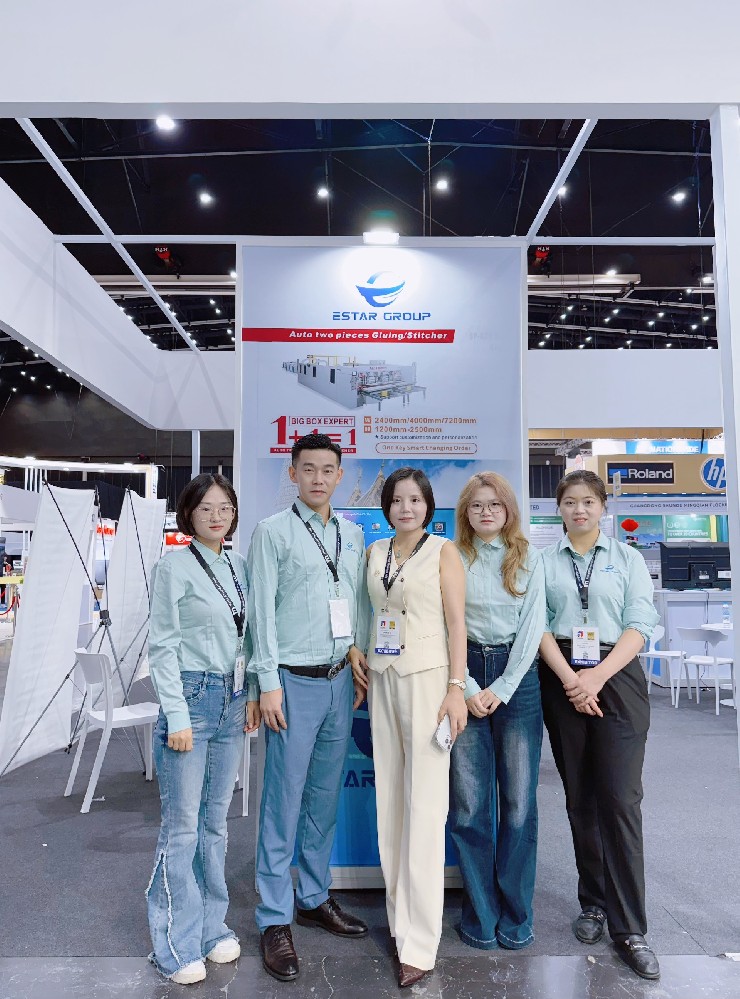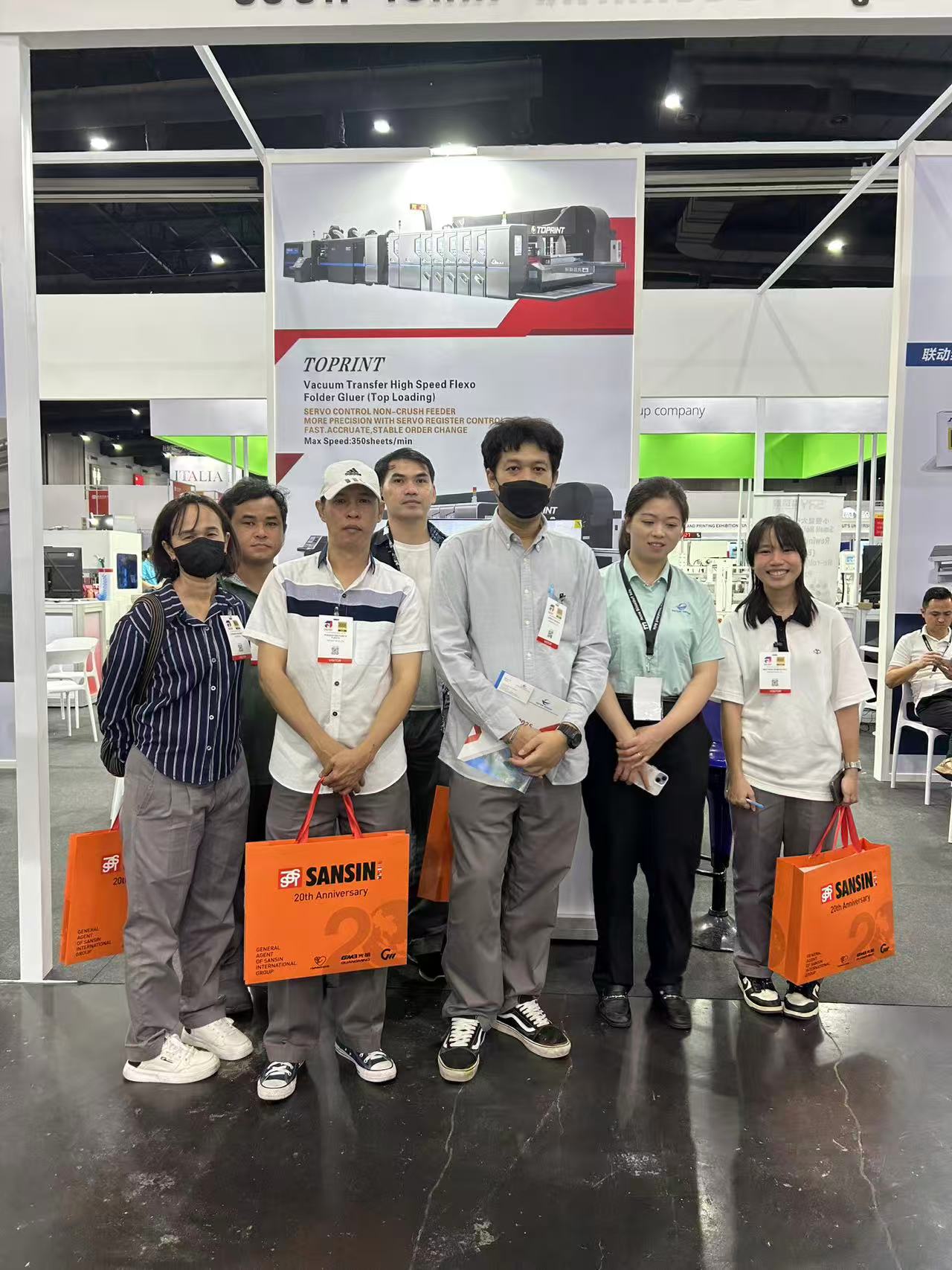Exhibition Dates: September 17-20, 2025


I. Exhibition Overview and Key Impressions
Corrpack & Print Thailand 2025 was held as scheduled at the Bangkok International Trade and Exhibition Centre (BITEC). As one of the most influential corrugated packaging exhibitions in Southeast Asia, this grand event brought together corrugated machines manufacturers,like Toprint flexo printer,Estar and INDEED folder gluer/stitcher,MRT automatic prefeeder,Taems robot palletizer systems, consumables suppliers, carton factories, and innovative design companies from around the world.
My key impression was that "green, smart, and efficient" have become irreversible mainstream trends in the industry. Compared to previous editions, this year's exhibition featured a significantly higher proportion of automated and digital solutions and sustainable material applications, fully reflecting the profound impact of supply chain restructuring, the explosion of e-commerce, and the global consensus on environmental protection on the packaging industry in the post-pandemic era.
II. Key Takeaways and Observations
1. Technological Innovation and Automated Solutions Are Core Competitiveness
· High-End Printing and Finishing Lines: Several leading European and Asian manufacturers (Bobst, Estar-Group, INDEED, MRT, etc.) showcased high-speed, high-precision digital pre-printing and flexo printing lines, as well as automatic die-cutting, folder gluing and stitching, and strapping and stacking machines. These machines significantly reduce manual intervention, improving production efficiency and stability, making them particularly suitable for handling high-volume, small-batch e-commerce orders.
· Industrial Internet of Things (IIoT) Applications: Many devices now feature data collection and remote monitoring capabilities as standard. Through a cloud platform, managers can view real-time data on each machine's operating status, production efficiency, and energy consumption, laying a solid foundation for implementing "smart factories" and lean production.
· Takeaways: We clearly see that investing in automatic and intelligent corrugated carton box production lines is no longer an option; it's a must for enhancing corporate competitiveness and reducing long-term operating costs.
2. Sustainable development moves from concept to full-scale practice
· Green materials take center stage: Corrugated cardboard featuring high-strength, lightweight base paper was widely featured at the exhibition, ensuring strength while reducing material consumption. Furthermore, biodegradable, recyclable, and environmentally friendly inks and adhesives were prominently featured by many suppliers.
· Innovative structural designs: Many design firms showcased integrated carton structures without plastic fillers, reusable express packaging solutions, and heavy-duty packaging designs that use corrugated cardboard instead of foam and wood. This is not only environmentally friendly but also reduces overall packaging costs for customers.
· Takeaways: Green packaging has become a mandatory requirement for international brands and consumers. We must integrate sustainable development into every aspect of product development and production. This is both a social responsibility and a "green pass" to expand into the high-end market.
3. The Southeast Asian market has enormous potential, and the competitive landscape is beginning to emerge.
· Strong market demand: With the rapid development of Southeast Asian e-commerce (such as Shopee and Lazada) and the relocation of manufacturing to the region, the demand for high-quality, innovative corrugated packaging has exploded. Many local and international buyers we met at the exhibition expressed their search for reliable and innovative packaging partners.
· Intensifying regional competition: In addition to local Thai companies, we also saw competitors from Vietnam, Indonesia, Malaysia, and other regions. They are also actively introducing new technologies and improving product quality. This means that to enter or expand into the Southeast Asian market, we must possess differentiated competitive advantages (such as rapid response, customized design, and stable quality).
· Learnings: Thailand, and Southeast Asia as a whole, are key growth markets that we must focus on. We need to develop targeted market strategies and consider local production or finding reliable local partners.
4. End-use industry demand drives packaging innovation
· New retail and e-commerce packaging: Personalized and protective packaging solutions are emerging for diverse categories, including fresh produce cold chain, luxury goods, and furniture and appliances. The unboxing experience is highly valued, and enhancing brand value through creative design and printing is becoming a consensus.
· Intelligent industrial packaging: Smart packaging boxes equipped with RFID tags and QR code traceability are beginning to be used in industrial logistics, helping customers achieve inventory management and supply chain visibility. Takeaways: We can't just focus on production; we must also look ahead and see the future. We need to proactively understand the development trends and pain points of end-use industries (such as electronics, food and beverages, and cosmetics) and transform from a "packaging manufacturer" to a "packaging solutions provider."
III. Implications and Suggestions for Our Company's Development
Based on the above observations, I offer the following suggestions:
1. Technology Upgrade Plan: I recommend that the company initiate an evaluation of its existing production lines, prioritizing the introduction of automated post-processing equipment to reduce reliance on skilled labor, improve efficiency, and enhance product consistency. At the same time, we should gradually deploy a production data management system to lay the foundation for a digital factory.
2. Product R&D Directions: Immediately establish or strengthen a green packaging R&D team, focusing on lightweight cardboard, the use of environmentally friendly materials, and innovative cardboard structure designs that can replace plastics. This will help us secure orders from international brands.
3. Market Expansion Strategy: Actively research market entry standards, customer needs, and the competitive landscape in Thailand and Southeast Asia. Consider leveraging the connections established at this exhibition to further engage with one or two potential local agents or partners.
4. Talent Team Building: We will strengthen team training in areas such as automatic flexo printer inline folder gluer/stitcher machine,automatic palletizer systems,automatic prefeeder operation and maintenance, green packaging design, and cross-border e-commerce packaging solutions to cultivate the talent we need for the future.
IV. Conclusion
This trip to the Thailand Corrugated Packaging Exhibition was not only an eye-opening industry event, but also a profound strategic reflection. We witnessed the tremendous changes in the industry driven by technology and environmental protection, and we also saw the enormous business opportunities in the Southeast Asian market. We must seize opportunities, actively embrace change, and accelerate the pace of transformation and upgrading to remain invincible in future market competition.